Abstract
Antigenic variants of influenza virus A/Mem/1/71-Bel/42 (H3N1) selected with monoclonal antibodies and having single substitutions in their hemagglutinins were examined for their ability to hemagglutinate and hemolyse erythrocytes coated with different gangliosides. The majority of variants, including one with a substitution near the receptor-binding site (Asn-133----Lys), did not differ from the parent in specificity for receptor molecules. However, a substitution in HA1 at residue 205 (Ser----Tyr), which is distant from the receptor-binding site in antigenic site D, affected hemagglutination and hemolysis of erythrocytes coated with sialyl-paraglobosides. The variant preferentially recognized N-acetylneuraminic acid-alpha 2,6-galactose linkages to sialylparaglobosides, whereas the parent and other variants preferentially recognized N-acetylneuraminic acid-alpha 2,3-galactose linkages. In the trimeric hemagglutinin molecule, residue 205 is located across the subunit interface from the receptor-binding site. The bulky hydrophobic tyrosine in the variant may cause a conformational change in the receptor-binding pocket on the neighboring subunit and influence receptor binding.
Full text
PDF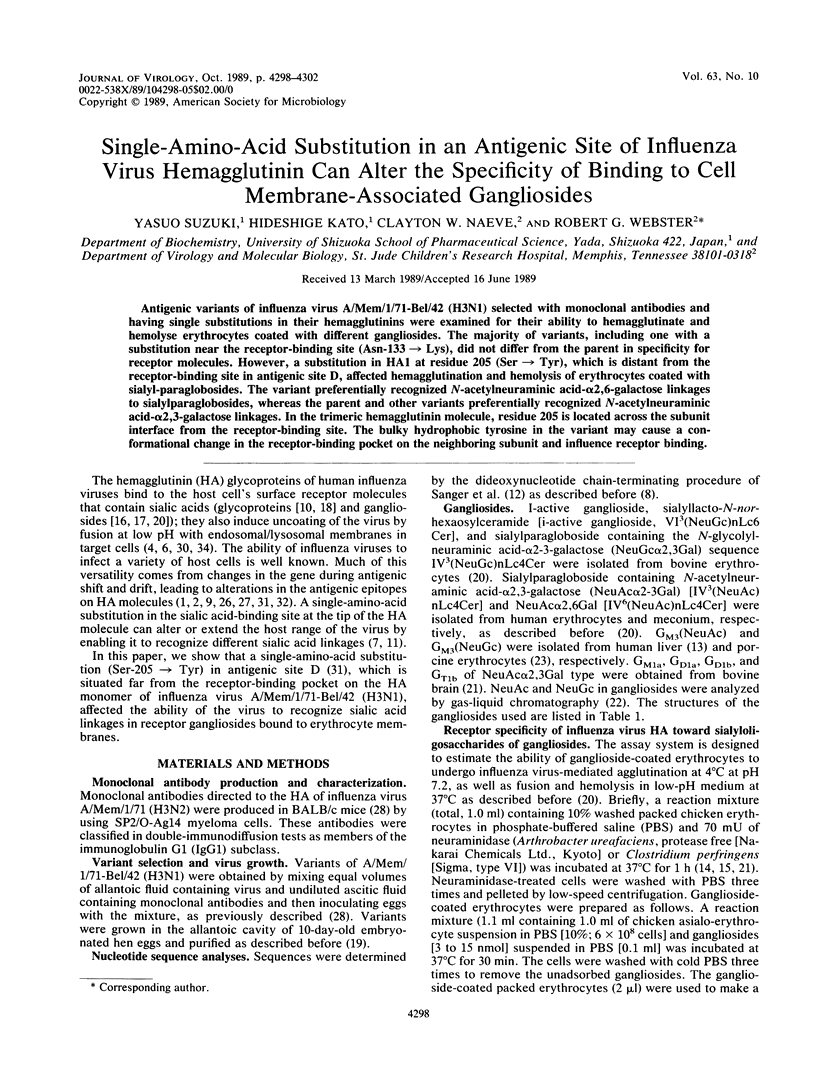
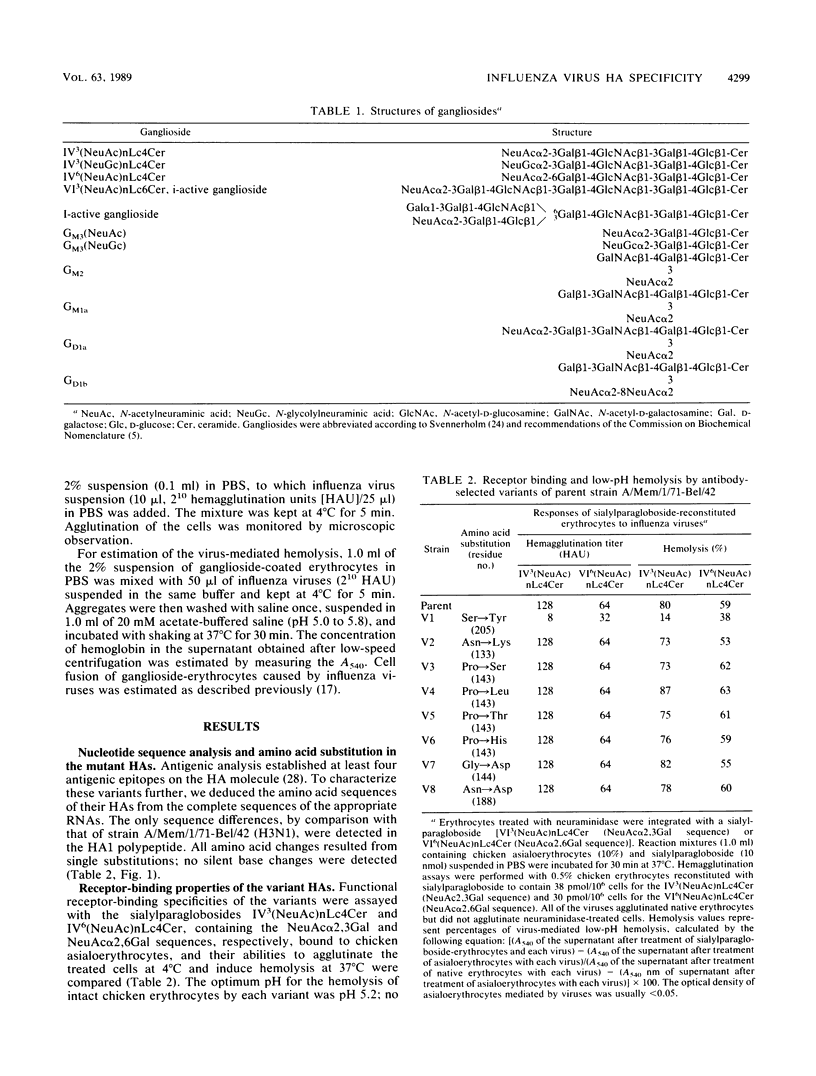
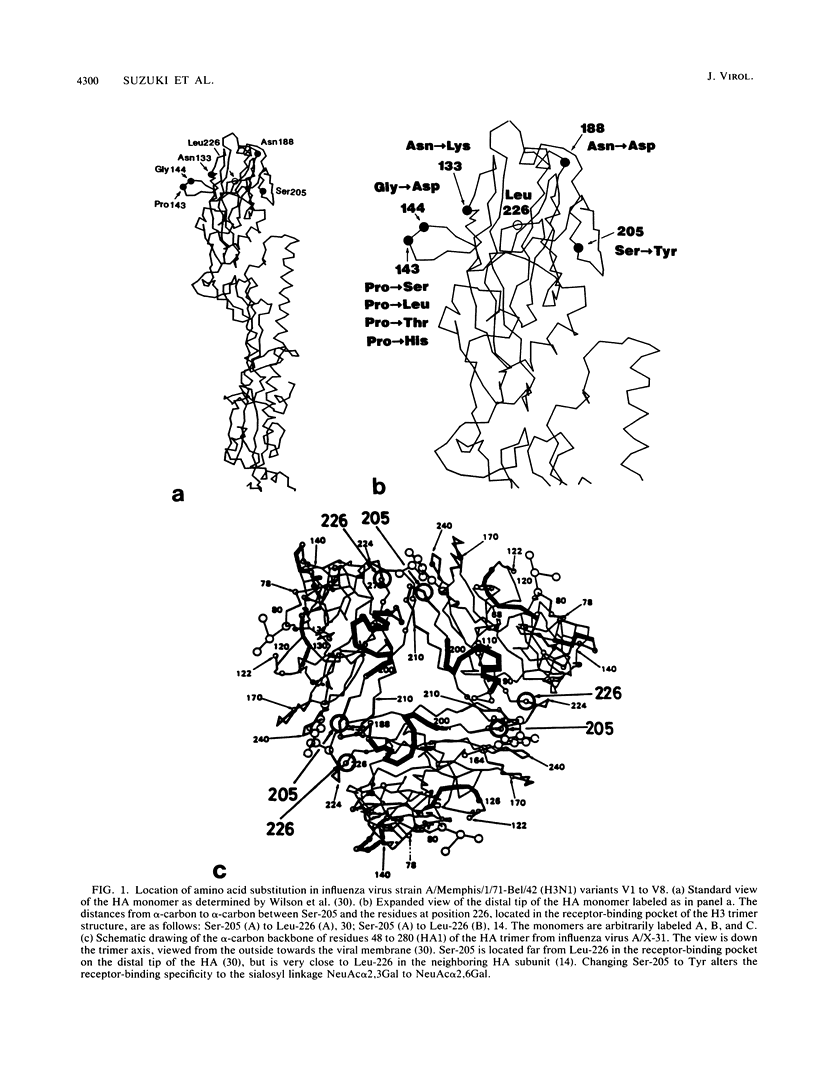
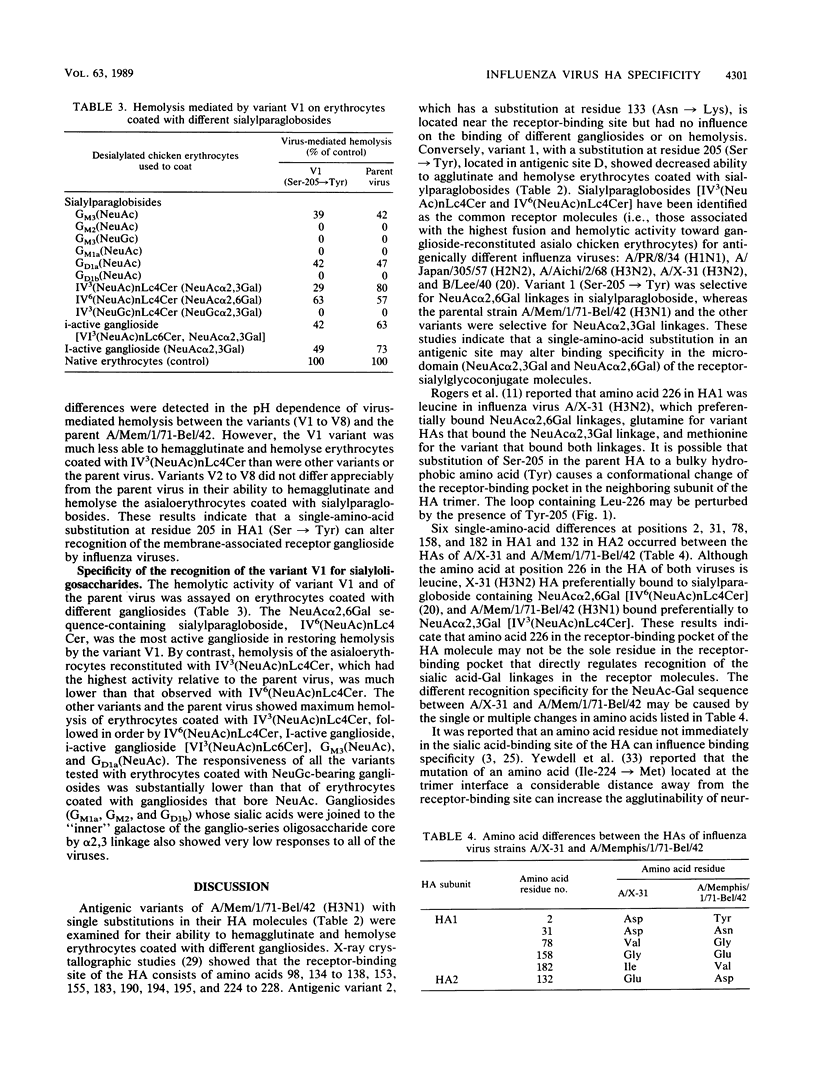
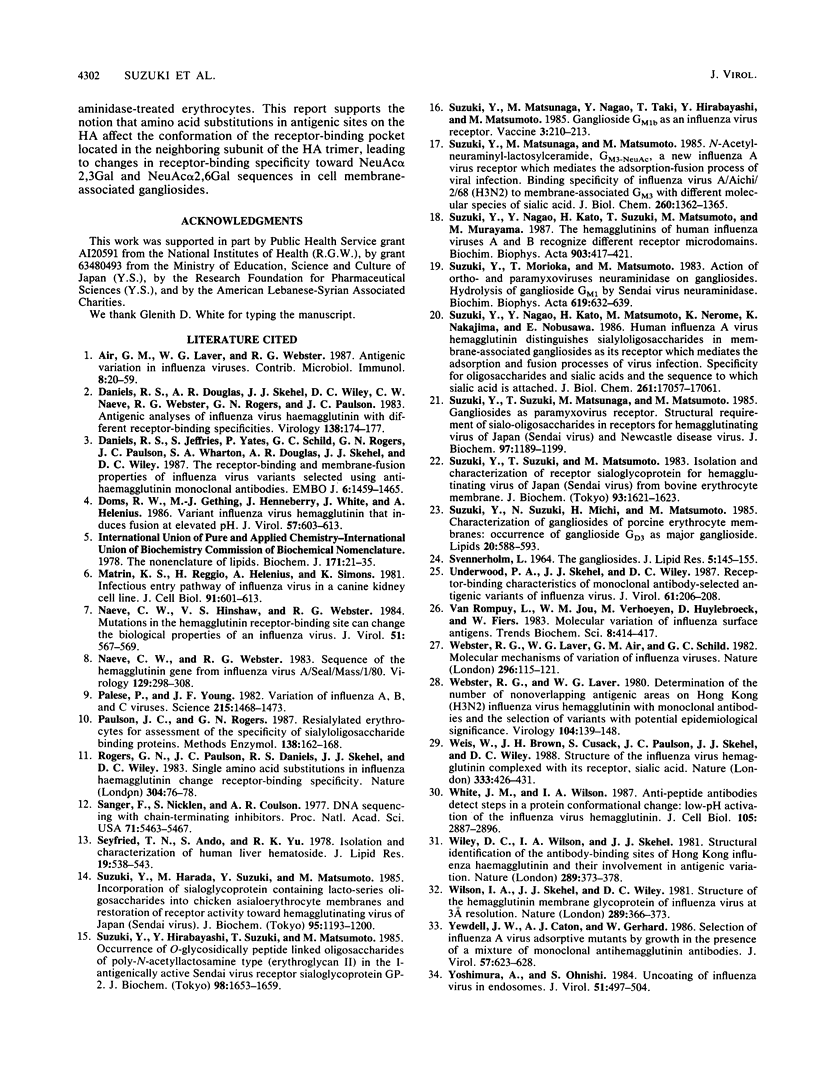
Selected References
These references are in PubMed. This may not be the complete list of references from this article.
- Air G. M., Laver W. G., Webster R. G. Antigenic variation in influenza viruses. Contrib Microbiol Immunol. 1987;8:20–59. [PubMed] [Google Scholar]
- Daniels P. S., Jeffries S., Yates P., Schild G. C., Rogers G. N., Paulson J. C., Wharton S. A., Douglas A. R., Skehel J. J., Wiley D. C. The receptor-binding and membrane-fusion properties of influenza virus variants selected using anti-haemagglutinin monoclonal antibodies. EMBO J. 1987 May;6(5):1459–1465. doi: 10.1002/j.1460-2075.1987.tb02387.x. [DOI] [PMC free article] [PubMed] [Google Scholar]
- Daniels R. S., Douglas A. R., Skehel J. J., Wiley D. C., Naeve C. W., Webster R. G., Rogers G. N., Paulson J. C. Antigenic analyses of influenza virus haemagglutinins with different receptor-binding specificities. Virology. 1984 Oct 15;138(1):174–177. doi: 10.1016/0042-6822(84)90158-2. [DOI] [PubMed] [Google Scholar]
- Doms R. W., Gething M. J., Henneberry J., White J., Helenius A. Variant influenza virus hemagglutinin that induces fusion at elevated pH. J Virol. 1986 Feb;57(2):603–613. doi: 10.1128/jvi.57.2.603-613.1986. [DOI] [PMC free article] [PubMed] [Google Scholar]
- Matlin K. S., Reggio H., Helenius A., Simons K. Infectious entry pathway of influenza virus in a canine kidney cell line. J Cell Biol. 1981 Dec;91(3 Pt 1):601–613. doi: 10.1083/jcb.91.3.601. [DOI] [PMC free article] [PubMed] [Google Scholar]
- Naeve C. W., Hinshaw V. S., Webster R. G. Mutations in the hemagglutinin receptor-binding site can change the biological properties of an influenza virus. J Virol. 1984 Aug;51(2):567–569. doi: 10.1128/jvi.51.2.567-569.1984. [DOI] [PMC free article] [PubMed] [Google Scholar]
- Naeve C. W., Webster R. G. Sequence of the hemagglutinin gene from influenza virus A/Seal/Mass/1/80. Virology. 1983 Sep;129(2):298–308. doi: 10.1016/0042-6822(83)90169-1. [DOI] [PubMed] [Google Scholar]
- Palese P., Young J. F. Variation of influenza A, B, and C viruses. Science. 1982 Mar 19;215(4539):1468–1474. doi: 10.1126/science.7038875. [DOI] [PubMed] [Google Scholar]
- Paulson J. C., Rogers G. N. Resialylated erythrocytes for assessment of the specificity of sialyloligosaccharide binding proteins. Methods Enzymol. 1987;138:162–168. doi: 10.1016/0076-6879(87)38013-9. [DOI] [PubMed] [Google Scholar]
- Rogers G. N., Paulson J. C., Daniels R. S., Skehel J. J., Wilson I. A., Wiley D. C. Single amino acid substitutions in influenza haemagglutinin change receptor binding specificity. Nature. 1983 Jul 7;304(5921):76–78. doi: 10.1038/304076a0. [DOI] [PubMed] [Google Scholar]
- SVENNERHOLM L. THE GANGLIOSIDES. J Lipid Res. 1964 Apr;5:145–155. [PubMed] [Google Scholar]
- Sanger F., Nicklen S., Coulson A. R. DNA sequencing with chain-terminating inhibitors. Proc Natl Acad Sci U S A. 1977 Dec;74(12):5463–5467. doi: 10.1073/pnas.74.12.5463. [DOI] [PMC free article] [PubMed] [Google Scholar]
- Seyfried T. N., Ando S., Yu R. K. Isolation and characterization of human liver hematoside. J Lipid Res. 1978 Jul;19(5):538–543. [PubMed] [Google Scholar]
- Suzuki T., Harada M., Suzuki Y., Matsumoto M. Incorporation of sialoglycoprotein containing lacto-series oligosaccharides into chicken asialoerythrocyte membranes and restoration of receptor activity toward hemagglutinating virus of Japan (Sendai virus). J Biochem. 1984 Apr;95(4):1193–1200. doi: 10.1093/oxfordjournals.jbchem.a134709. [DOI] [PubMed] [Google Scholar]
- Suzuki Y., Hirabayashi Y., Suzuki T., Matsumoto M. Occurrence of O-glycosidically peptide-linked oligosaccharides of poly-N-acetyllactosamine type (erythroglycan II) in the I-antigenically active Sendai virus receptor sialoglycoprotein GP-2. J Biochem. 1985 Dec;98(6):1653–1659. doi: 10.1093/oxfordjournals.jbchem.a135436. [DOI] [PubMed] [Google Scholar]
- Suzuki Y., Matsunaga M., Matsumoto M. N-Acetylneuraminyllactosylceramide, GM3-NeuAc, a new influenza A virus receptor which mediates the adsorption-fusion process of viral infection. Binding specificity of influenza virus A/Aichi/2/68 (H3N2) to membrane-associated GM3 with different molecular species of sialic acid. J Biol Chem. 1985 Feb 10;260(3):1362–1365. [PubMed] [Google Scholar]
- Suzuki Y., Morioka T., Matsumoto M. Action of ortho- and paramyxovirus neuraminidase on gangliosides. Hydrolysis of ganglioside GM1 by Sendai virus neuraminidase. Biochim Biophys Acta. 1980 Sep 8;619(3):632–639. [PubMed] [Google Scholar]
- Suzuki Y., Nagao Y., Kato H., Matsumoto M., Nerome K., Nakajima K., Nobusawa E. Human influenza A virus hemagglutinin distinguishes sialyloligosaccharides in membrane-associated gangliosides as its receptor which mediates the adsorption and fusion processes of virus infection. Specificity for oligosaccharides and sialic acids and the sequence to which sialic acid is attached. J Biol Chem. 1986 Dec 25;261(36):17057–17061. [PubMed] [Google Scholar]
- Suzuki Y., Nagao Y., Kato H., Suzuki T., Matsumoto M., Murayama J. The hemagglutinins of the human influenza viruses A and B recognize different receptor microdomains. Biochim Biophys Acta. 1987 Oct 16;903(3):417–424. doi: 10.1016/0005-2736(87)90048-4. [DOI] [PubMed] [Google Scholar]
- Suzuki Y., Suzuki N., Michi H., Matsumoto M. Characterization of gangliosides of porcine erythrocyte membranes: occurrence of ganglioside GD3 as major ganglioside. Lipids. 1985 Sep;20(9):588–593. doi: 10.1007/BF02534284. [DOI] [PubMed] [Google Scholar]
- Suzuki Y., Suzuki T., Matsumoto M. Isolation and characterization of receptor sialoglycoprotein for hemagglutinating virus of Japan (Sendai virus) from bovine erythrocyte membrane. J Biochem. 1983 Jun;93(6):1621–1633. doi: 10.1093/oxfordjournals.jbchem.a134301. [DOI] [PubMed] [Google Scholar]
- Suzuki Y., Suzuki T., Matsunaga M., Matsumoto M. Gangliosides as paramyxovirus receptor. Structural requirement of sialo-oligosaccharides in receptors for hemagglutinating virus of Japan (Sendai virus) and Newcastle disease virus. J Biochem. 1985 Apr;97(4):1189–1199. doi: 10.1093/oxfordjournals.jbchem.a135164. [DOI] [PubMed] [Google Scholar]
- Underwood P. A., Skehel J. J., Wiley D. C. Receptor-binding characteristics of monoclonal antibody-selected antigenic variants of influenza virus. J Virol. 1987 Jan;61(1):206–208. doi: 10.1128/jvi.61.1.206-208.1987. [DOI] [PMC free article] [PubMed] [Google Scholar]
- Webster R. G., Laver W. G., Air G. M., Schild G. C. Molecular mechanisms of variation in influenza viruses. Nature. 1982 Mar 11;296(5853):115–121. doi: 10.1038/296115a0. [DOI] [PubMed] [Google Scholar]
- Webster R. G., Laver W. G. Determination of the number of nonoverlapping antigenic areas on Hong Kong (H3N2) influenza virus hemagglutinin with monoclonal antibodies and the selection of variants with potential epidemiological significance. Virology. 1980 Jul 15;104(1):139–148. doi: 10.1016/0042-6822(80)90372-4. [DOI] [PubMed] [Google Scholar]
- Weis W., Brown J. H., Cusack S., Paulson J. C., Skehel J. J., Wiley D. C. Structure of the influenza virus haemagglutinin complexed with its receptor, sialic acid. Nature. 1988 Jun 2;333(6172):426–431. doi: 10.1038/333426a0. [DOI] [PubMed] [Google Scholar]
- White J. M., Wilson I. A. Anti-peptide antibodies detect steps in a protein conformational change: low-pH activation of the influenza virus hemagglutinin. J Cell Biol. 1987 Dec;105(6 Pt 2):2887–2896. doi: 10.1083/jcb.105.6.2887. [DOI] [PMC free article] [PubMed] [Google Scholar]
- Wiley D. C., Wilson I. A., Skehel J. J. Structural identification of the antibody-binding sites of Hong Kong influenza haemagglutinin and their involvement in antigenic variation. Nature. 1981 Jan 29;289(5796):373–378. doi: 10.1038/289373a0. [DOI] [PubMed] [Google Scholar]
- Wilson I. A., Skehel J. J., Wiley D. C. Structure of the haemagglutinin membrane glycoprotein of influenza virus at 3 A resolution. Nature. 1981 Jan 29;289(5796):366–373. doi: 10.1038/289366a0. [DOI] [PubMed] [Google Scholar]
- Yewdell J. W., Caton A. J., Gerhard W. Selection of influenza A virus adsorptive mutants by growth in the presence of a mixture of monoclonal antihemagglutinin antibodies. J Virol. 1986 Feb;57(2):623–628. doi: 10.1128/jvi.57.2.623-628.1986. [DOI] [PMC free article] [PubMed] [Google Scholar]
- Yoshimura A., Ohnishi S. Uncoating of influenza virus in endosomes. J Virol. 1984 Aug;51(2):497–504. doi: 10.1128/jvi.51.2.497-504.1984. [DOI] [PMC free article] [PubMed] [Google Scholar]


